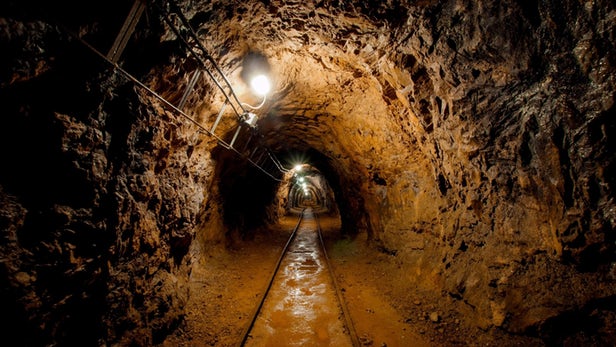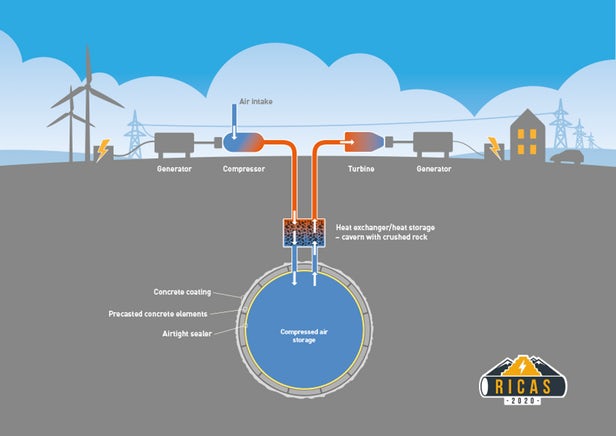Creating renewable energy storage out of hot air

Old mines could get a second lease of life as energy storage caverns if a compressed air storage system proposal by EU scientists gets the green light (Credit: svedoliver/Depositphotos)
The rapid growth of solar arrays and wind farms might sound like a win for the environment, but storing renewable sources of energy efficiently on the grid remains a challenge for energy providers. EU scientists are turning to a cheap and plentiful natural resource for the answer: air.
While flow batteries and various other smart grid technologies have emerged in recent years to address the problem of renewable energy storage, a number of scientists are revisiting a decades-old method: compressed air energy storage (CAES). It involves using surplus electricity (either from a power plant or renewable energy) to compress air, which is then stored in an underground cavern. When power is needed, the air is released through a gas turbine that generates electricity. On paper, it is an attractive solution: it is, theoretically, one of the cheapest ways to store massive amounts of energy and compared to hydropower reservoirs, it doesn't require facilities to be situated in the mountains, which not every country has.
Sick of Ads?
More than 700 New Atlas Plus subscribers read our newsletter and website without ads.
Join them for just US$19 a year.
More InformationHowever the process of compressing air results in the production of heat, just like what happens to a bicycle pump when it heats up while filling your tires. The problem here is what to do with the heat that's generated. At present, there are only two CAES plants in the world – the Huntorf plant in Germany and the McIntosh plant in Alabama, USA, which have peak capacities of 290 MW and 226 MW respectively. At both facilities, the heat is released as a by-product of the compression process as neither has the infrastructure to process and store it. Apart from losing a potential source of energy, what this also means is that the air needs to be heated up again, often with natural gas, to run the turbines that generate electricity. This reduces the energy efficiency of the system.
To address this issue, scientists working on the EU-funded RICAS 2020 project are turning to advanced adiabatic CAES (AA-CAES) to develop a design concept that enables heat storage.
A key component of this project is a section that enables the heat to be siphoned off during the compression process. As shown in the illustration below, after the air leaves the compressor, it passes through a cavern filled with crushed rocks, which absorb its heat. The cold air then makes its way down to the main cavern where it is stored. When it is needed, it makes its way back through the crushed rocks, where it is reheated, before being discharged, thus eliminating the need to burn fuel.
Giovanni Perillo, a materials scientist at SINTEF who is one of the project managers on the project, believes this technology has the potential to offer a better alternative to batteries due to its longer lifetime and lower capital cost per kWh of stored energy. Also, compared to existing storage sites, which have an efficiency rate of 45 to 55 percent and produce only half of the energy used in the air compression process, this new system could raise the rate to as much as 70 to 80 percent.
"The more of the heat of compression that the air has retained when it is released from the store, the more work it can perform as it passes through the gas turbine," he says. "And we think that we will be able to conserve more of that heat than current storage technology can, thus increasing the net efficiency of the storage facilities."
Another advantage that this AA-CAES technology offers is that it is not limited to certain geological formations. While the facilities do have to be located in places where large hollow spaces already exist, the researchers say these could also include disused caverns and mines. The RICAS 2020 project, for example, is being conducted in an abandoned mine in Austria.
That said, for the project to move past the design phase, which would be a first for an AA-CAES project, it has to meet a few conditions. These include developing a sealing membrane that can withstand the cavern's high temperatures and pressure. Based on the results and cost analyses, a decision on whether to move forward with a pilot plant will then be made.
Despite being around for decades, compressed air has yet to realize its potential in the renewable energy sector. This is due to a number of reasons, says Matthias Finkenrath, a professor of energy engineering at Germany's Kempten University of Applied Science, who cites technological challenges, low energy prices and uncertainties in the energy market as factors that have caused plans for large-scale facilities to stall or be abandoned. One example is the US$400 million Iowa Stored Energy Park, which was scrapped in 2011 after studies showed that the state's sandstone aquifers weren't suitable for CAES.
That said, these setbacks have not stopped dimmed its appeal as scientists and those in the industry look for ways to improve the storage of off-peak generated renewable energy on the grid. Compared to the chemical compounds in cell-based battery systems, air costs nothing, won't degrade and is all around us. With places such as Hawaii launching initiatives to rely on renewable sources for the majority of its energy needs, compressed air storage could make wind power as dependable as energy generated by fossil fuels if scientists can figure out how to harness it and overcome the various geological challenges.
"Compressed air stores of the sort that this project is aiming for, could provide significantly lower costs and greatly improve storage capacity compared to for example batteries," says Finkenrath. "If this project leads to storage plants being established under a wide range of geological conditions, that in itself would be an important step forward.
"If the project partners are also successful with their plans for efficient heat storage, the use of compressed air for energy storage could be on the edge of a breakthrough."
Source: SINTEF
